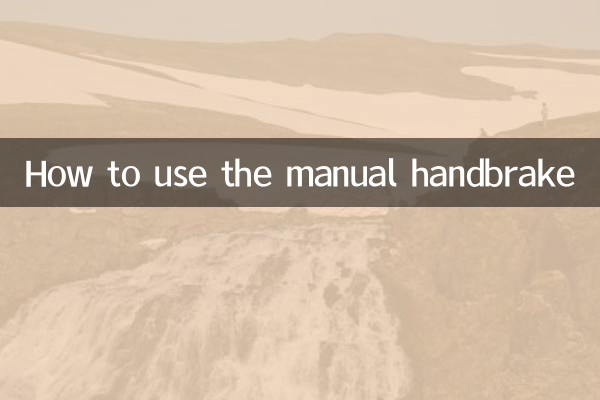How to use the manual handbrake: comprehensive analysis and operation guide
The handbrake (parking brake) of a manual transmission car is an important part of vehicle safety, especially when parking on a slope or for a long time. This article will analyze the structure, usage, precautions and common problems of the handbrake in detail to help drivers master the correct operation skills.
1. Basic structure and principle of handbrake

A manual handbrake usually consists of a handle, a cable, and a brake shoe (or caliper). It realizes rear wheel braking through mechanical force transmission. Its principle is different from that of the foot brake (hydraulic brake). It is a purely mechanical device and can be used in the flameout state.
| Part name | Function description |
|---|---|
| handle/button | Operating body, locked when pulled up, released after pressing the button |
| brake cable | Transfer handle pull force to rear wheel braking system |
| Braking mechanism | Drum or disc brakes for physical locking |
2. Steps to correctly use the handbrake
1.Operate while parking: Depress the brake pedal → shift into neutral → pull up the handbrake → release the foot brake → turn off the engine (on slopes, first shift into 1st gear or reverse gear).
2.Operation at start: Depress the clutch and engage in 1st gear → lightly depress the accelerator until the speed reaches 1000 rpm → slowly release the clutch to semi-linkage → release the handbrake → continue to refuel and start.
| scene | Operational points |
|---|---|
| Parking on flat ground | Just pull the handbrake to 70% strength |
| ramp parking | It needs to be pulled to the highest position. It is recommended to put it into gear. |
| Winter use | Avoid pulling it up for a long time to prevent freezing |
3. Common mistakes and precautions
1.Do not pull the handbrake while driving: Easy to cause the rear wheel to lock and slide.
2.Regular inspection: The slack in the cable needs to be adjusted in time (standard stroke 6-8 teeth)
3.alternative: Automatic transmission models need to shift to P first and then apply the handbrake.
4. Handbrake related data reference
| parameter | Standard value |
|---|---|
| Effective number of teeth | 5-7 teeth (when pulled up) |
| Braking force requirements | ≥20% vehicle weight |
| Maintenance cycle | Check cable tension every 2 years |
5. Answers to popular questions
Q: What should I do if the handbrake cannot be released?
A: It may be that the button is stuck or the cable is frozen. Try pressing the button repeatedly and gently shaking the handle. In winter, you can pour warm water on the braking part.
Q: Can electronic handbrake replace traditional handbrake?
A: The electronic handbrake integrates the ABS function, but the mechanical handbrake is more reliable in emergency braking and failure. Both have their own advantages.
Summarize: Correct use of the handbrake requires consideration of the vehicle status and road conditions. It is recommended to test the handbrake performance once a month: pull the handbrake on a 30-degree slope, and the vehicle should remain stationary and not roll away. Mastering these skills will greatly improve driving safety.

check the details

check the details